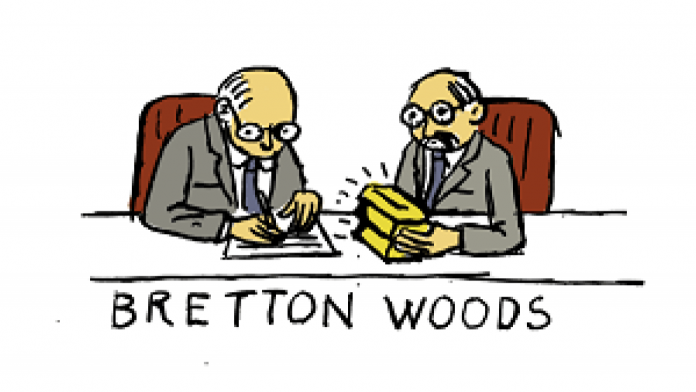Hello Guys, What’s up?
Hope you’re having a wonderful time at home.
How is your preparation for SSC CGL GK going on?
In our previous blogs, we’ve discussed the Basic Concepts of Economics.
Today, the topic which we will cover in this blog is The Bretton Woods Agreement, a very informative topic for SSC GK.
Let’s Start,
Table of Contents
The Backdrop
The defining entity of the 20th Century- the World Wars!
In the 1930s, the economy of Germany crashed and after the Second World War, major economies were in ruins, they needed cash and other financial support to rebuild their infrastructure.
Thus, after the Second World War (1939-1945), the winners, i.e. the Allied Nations met in a place called Bretton Woods in New Hampshire, USA. These countries agreed to create a new global monetary system, with new financial institutions dominated by US Dollar. This new system replaced the erstwhile Gold Standard. Hence, USA became an economic powerhouse, as only the US could print the dollars.
The Agreement
The 44 Allied Nations agreed to establish two new institutions, namely,
1. The World Bank, formally called International Bank for Reconstruction and Development
2. The IMF – International Monetary Fund,
Together these are known as Bretton Woods Twins, both headquartered in Washington DC, USA.
They also agreed that their central banks (like the RBI in India) would maintain fixed exchange rates between the dollar and their own currencies, replacing the Gold Standard.
What exactly was the Gold Standard?
As the name suggests, in this system, each country guaranteed that it would redeem its currency for its value in Gold. In simple terms, greater the amount of Gold that a country has, more valuable is the currency. Why Gold, because it’s the most valuable metal since time immemorial (ignoring the metals used for scientific purposes). In Bretton Woods, the countries agreed to redeem their currency for US Dollar, not Gold.
But why Dollars, why not Euro or the Indian Rupee?
Because at that time, US had 3/4th of the world’s supply of gold. No other country had enough gold to back its currency as replacement. At that time, $1=1/35 of an ounce of Gold.
Quite a Robust system, wasn’t it? But guess what, this system collapsed 3 decades later, on which we would take a look later on.
Role of Bretton Woods System in World Economy
Member countries needed a Global bank from where they could borrow if their currency values got too low. Otherwise, they would have to increase rates or institute trade barriers, which would benefit no one in the longer run. World Bank was set up to lend money to European countries to reconstruct themselves after WW2. World Bank also lent money to emerging countries like India.
IMF fostered monetary stability in the World Economy. It oversees and monitors the financial and economic policies of member nations. It facilitates international trade, promotes high employment and sustainable economic growth, and reduces poverty in the world.
The Collapse of Bretton Woods Agreement
There was massive Stagflation* in the US economy in early 1970s. The economy went into recession causing big unemployment. The US deflated the dollar’s value to 1/38 of an ounce of gold and then 1/48 of an ounce. People panicked and started to buy gold paying in dollars, due to which gold’s price skyrocketed to 120$ per ounce, which shattered people’s trust in the US Dollar and hence the system collapsed!
The New System
Today we neither use gold standard nor the Bretton Woods Agreement; we are using something which is known as “Floating Exchange Rates”. In this system, market forces determine the value of currencies relative to one another. In layman’s terms, the value of Rupee as compared to US $ will be determined by the trade we are having with the US economy. Similarly, the value of Euro as compared to Pound will be determined by the trade Europe is having with the United Kingdom. The “Floating Exchange Rate System” is a topic in itself, which we will cover in subsequent blogs!
Read till the end to get access to our bonus content.
Summary and Quick Bytes
1) 44 Allied Nations met in Bretton Wood, USA in July 1944 to establish new financial system.
2) International Monetary Fund (IMF)
- Established in 1944, started functioning in 1947.
- Managing Director- Kristalina Georgieva
- Chief Economist- Gita Gopinathan
- Headquartered at Washington DC, USA.
3) International Bank for Reconstruction and Development (IBRD)
- Commonly known as the World Bank
- Established in 1944
- Headquartered at Washington DC, USA.
- President- David Malpass
4) IMF and World Bank are together known as Bretton Woods twins.
5) The World Bank Group today, has, 5 member institutions
a) IBRD- International Bank for Reconstruction and Development
b) IDA- International Development Association
c) IFC- International Finance Corporation
d) MIGA- Multilateral Investment guarantee agency
e) ICSID- International Centre for settlement of investment disputes
6) In Bretton Woods, Gold Standard was replaced by US Dollar, which itself was abandoned in 1970s.
7) Current System is the “Floating Exchange Rate” system.
Bonus Content
1) The agreement also included plans for the International Trade Organization, but it was not formed until 1990s when World Trade Organization (WTO) was formed in 1995. It is headquartered in Geneva, Switzerland.
2) India was represented by Sir CD Deshmukh at the Bretton Woods Conference. He was the first Governor of RBI (no, this person has no relation with the great Riteish Deshmukh).
3) The architects of the agreement were
- John Maynard Keynes, British Economist
- Henry Morgenthau Jr, US Secretary of Treasury, 1944
- Harry Dexter White, Official, Us Treasury.
*Stagflation:
Persistent high inflation combined with high unemployment and stagnant demand in economy is termed as Stagflation.
Hope this blog cleared all your doubts pertaining to The Bretton Woods Agreement for SSC CGL General Awareness Examination.
Stay Tuned for some more awesome content for SSC CGL Exam
In our next blog, we will be discussing other current issues of national and international importance. If you don’t want to miss out on the next important blog, click here!
Thank You for Reading
All the Best!!!




